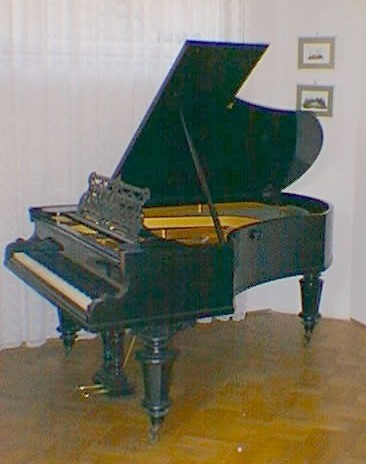
CLOCK REPAIR
What is the difference between reconditioning and rebuilding?
Reconditioning generally refers to overhauling the piano without replacing parts. It includes things like regulation, hammer reshaping, key rebushing. Rebuilding, which is sometimes done along with refinishing, can involve replacing strings, tuning pins, pinblock, hammers, action, etc. A rebuilt piano should play and sound as well as when the piano was new.
Is it worth rebuilding an old piano?
Because rebuilding is such a huge job, it is often questionable whether it is worth doing to an average or lesser quality piano. Certainly if a piano has sentimental value or if the owner wants it to play at its best, I will be happy to do the work. But in most cases, a complete rebuild is done to pianos with better quality names. It may actually cost less to buy a brand new piano then to rebuild and refinish an older one. (This is primarily because of cheaper labor overseas.) Many older pianos are of poor quality and never sounded that good to begin with; a few older pianos still sound great after 75 years, even without a complete rebuilding.
How can I tell if a piano has been rebuilt?
It is difficult for an untrained eye to determine how much work has been done to a piano. Often the piano has had less work done then people think. I've seen many pianos that were supposedly "rebuilt", when all that was done is keytops and a paint job.
What is involved in rebuilding a piano?
For a complete rebuild, the piano is taken completely apart. The strings are removed, as well as the tuning pins. Then the cast iron plate must be lifted off. This weighs several hundred pounds and requires an engine hoist. The pinblock, which hold the tuning pins under enormous stress, should be replaced with an exact duplicate. The bass strings have to be custom made to precisely fit the piano. The soundboard gets repaired or replaced if necessary and refinished. The plate (harp) also gets refinished. The action is taken apart and parts are replaced. The key bushing felt is replaced. When everything is put back together, a great deal of adjustment (regulation) and many tunings are needed to stabilize the piano. The entire process can take a few months.
Can you still get parts for older pianos?
Most piano parts from the last 100 years or so are still available. For the occassional older or oddball piano, parts can be substituted or custom made as needed.
Can a Steinway be rebuilt with non-Steinway parts?
Steinway will disagree, but many rebuilders sometimes use non Steinway parts with excellent results. For example, I often use Renner hammers when replacing hammers on a Steinway piano. They sound great and do not require adding tons of noxious lacquer to get any tone out of them, as Steinway hammers do.
Is a complete rebuild always necessary for older pianos?
There are different schools of thought on whether it is always advantageous to replace everything. Some old soundboards sound better to me than some new ones. Even old hammers can sound good sometimes if they have enough felt left. I'm not a believer in replacing everything on a piano just because it's in the shop. However, parts that could fail in the future (such as a pinblock) are better off being replaced once a piano is taken apart.
Is rebuilding a piano a good investment?
Yes and no. You may not be able to sell the piano for what you pay to rebuild it. However, the piano may give you another 50 to 100 years of use with proper care. If you like the piano and use it, it seems to me worth investing in getting it to play its best.
Is real ivory still available?
Ivory has generally not been used since the 1950's. Some people prefer the feel of genuine ivory, as it is more porous than plastic. If a few ivories are missing or chipped, I can replace them with salvaged ivory. If too many are damaged or missing it is generally more practical to replace them with plastic (although bone is an available alternative). I also offer bleaching of yellow ivories.
What if a piano has a cracked soundboard?
Cracks in a soundboard do not normally effect the sound of the piano. However, if the soundboard becomes unglued from the ribs, it may develop unpleasant noises. More than anything, it is an indication that the piano is too dry. Sometimes cracks will disappear when the humidity rises. Cracks can be repaired during piano rebuilding, although this is done partly for cosmetic reasons. During the soundboard repair, the board is reglued to the ribs wherever there is separation occuring. This will prevent noises that can occur in an old soundboard.

